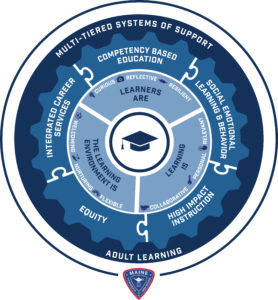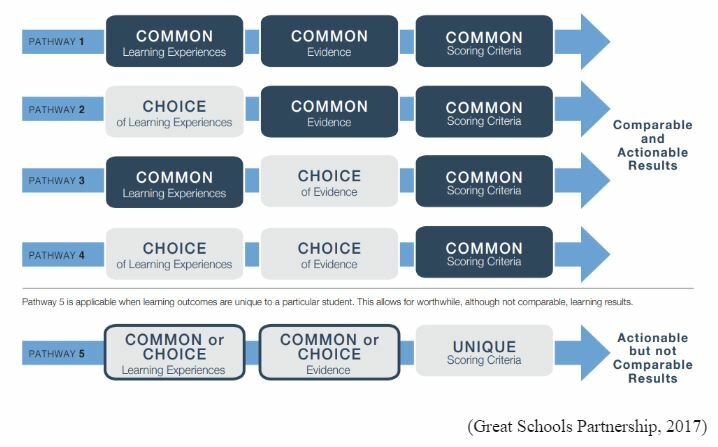Maine Township High School District 207
White Paper: Competency-Based Education
Dr. Shawn P. Messmer
Introduction
Competency-Based Education (CBE) is an educational approach that focuses on assessing students based on their ability to demonstrate specific knowledge and skills, rather than on their time spent in a classroom or on the completion of traditional coursework. CBE programs are designed to provide students with flexible, personalized learning experiences that allow them to progress at their own pace and to demonstrate their competencies in a variety of ways.
Background:
CBE has its roots in the late 1960s and early 1970s with the work of Benjamin Bloom and his introduction of the concept of mastery learning. Bloom’s Taxonomy has been a pillar of educational pedagogy since this time period. After the publication of the Coleman Report in 1965, educators began to question the traditional approach to education, which emphasized seat time and the completion of courses over student learning and achievement. In recent years, the advent of new technologies and the growing demand for more flexible and personalized learning experiences have led to renewed interest in CBE as educational technology has the potential to overcome the often cited barriers to this approach taking hold.
Benefits of CBE:
CBE offers several advantages over traditional education models. For example, it allows students to progress at a negotiated pace with the support of the classroom teacher which can be especially beneficial for students who are working or who have other responsibilities that make it difficult to attend traditional classes. Negotiated pacing also allows students to slow down to ensure concepts are mastered and go deeper when a student has the skillset, knowledge and interest to access more complex aspects of a topic. It therefore follows that CBE can provide students with more control over their learning experiences, which can lead to greater engagement and motivation. CBE centers autonomy, mastery, and purpose – three elements essential to moving education from a compliance model to a model that harnesses the natural curiosity of humans that seeks to develop student efficacy with the purpose of teaching students how to learn.
CBE also has the potential to improve student outcomes by focusing on the development of specific competencies and skills that are relevant to the workforce. This approach can also help students to better understand the connections between what they are learning and the real world, which can lead to greater retention of information and deeper understanding.
Definition of CBE in District 207:
CBE is a framework for implementing a suite of best practices designed to empower students through individual choice that emphasizes the application of content knowledge and skills through authentic assessment. Disciplinary skills and content are designed to go deeper into essential competencies in which all students must be able to demonstrate proficiency.
Why is District 207 moving to Competency-Based Education?
District 207 is implementing CBE to fulfill its mission to improve learning by providing equitable access and opportunity for all students to reach proficiency in a personalized curriculum centered on common rigorous learning expectations with the goal of ensuring that all students are prepared for success after high school by learning how to learn, while building on individual assets and amplifying student voice.
CBE is the framework through which District 207 can realize the goals of its Strategic Plan. CBE also supports District 207’s Vision of Learning:

Curious: Learner inquires about and questions content at a deep and personal level.
Reflective: Learners can articulate their personal learning journey using routine reflective practices.
Resilient: Failure is accepted as a necessary part of the learning process.
Collaborative: Learning is a social activity.
Personal: Learning progressions are based on student interest and are adapted to meet individual student needs.
Relevant: Foundational learning outcomes have broad application across multiple disciplines and are clearly connected to essential skills required for success in life.
Welcoming: The school culture fosters a sense of belonging and acceptance.
Nurturing: The school culture acknowledges the wants, needs, and goals of individuals and systemically supports their pursuit.
Flexible: The school culture supports the belief that learning occurs in a multitude of settings and through a multitude of modalities that are centered around the preferences of students.
Implementing CBE in District 207:
Implementing CBE requires a significant shift in the way that education is delivered and assessed. This includes changes to curriculum, instruction, and assessment, as well utilizing technology and emphasizing educational best practices to support personalized learning.
Teachers are supported as they make the move to CBE through profession learning focused on cooperative learning, differentiated instruction, assessment literacy, differentiated assessment, blended learning, and equity. While teachers in District 207 have access to this professional learning at any time, the district and building leadership teams prescribe this for teachers as their department begins tackling the move to CBE for their discipline.
As each department moves to CBE, district and building administrators create core teams of 20 to 30 individuals, the majority of whom are teachers, to work through the change elements of the process and to share the changes being suggested with the entire district-wide department for feedback.
 This implementation process reflects the two foundational elements of how District 207 puts its strategic plan into action. At the heart of this change is Multi-Tiered Systems of Support (MTSS). MTSS is utilized to make all learning accessible to all learners, which consequently is the definition of equity. Additionally, successful implementation of CBE rests on a high quality adult learning program. Unlike most school districts, District 207 has job-embedded, high quality adult learning support by every teacher having an individual coaching plan every year to ensure all certified staff is getting what it needs to make the changes necessary to evolve our antiquated educational system to one that can meet the needs of a rapidly changing world of work.
This implementation process reflects the two foundational elements of how District 207 puts its strategic plan into action. At the heart of this change is Multi-Tiered Systems of Support (MTSS). MTSS is utilized to make all learning accessible to all learners, which consequently is the definition of equity. Additionally, successful implementation of CBE rests on a high quality adult learning program. Unlike most school districts, District 207 has job-embedded, high quality adult learning support by every teacher having an individual coaching plan every year to ensure all certified staff is getting what it needs to make the changes necessary to evolve our antiquated educational system to one that can meet the needs of a rapidly changing world of work.
Key Elements of CBE in District 207:
One key element of CBE is the use of assessments that are directly linked to specific competencies and that are designed to measure student learning and achievement in a variety of ways. These assessments go beyond traditional tests and quizzes as performance tasks, projects, and other forms of assessment that are designed to measure students’ abilities to apply what they have learned in real-world contexts become the true measure of student learning.
Another key element of CBE is de-tracking. De-tracking classes, also known as ability grouping or tracking, is a practice where students are placed in different classes or groups based on their perceived academic abilities. District 207 is de-tracking classes for a number of reasons, including:
- Eliminating the opportunity gap: Research has shown that de-tracking can lead to more equitable academic outcomes for students from historically marginalized groups.
- Improving teacher quality: When classes are de-tracked, teachers are able to work with a more diverse group of students, which can lead to more effective and innovative teaching practices.
- Promoting social and emotional development: When students are placed in more heterogeneous classes, they are exposed to a wider range of perspectives and experiences, which can promote empathy, critical thinking, and problem-solving skills – all key to workplace success.
- Reducing social stratification: Tracking can reinforce social hierarchies and perpetuate stereotypes, de-tracking can help to reduce these negative effects.
- Encouraging students to reach their full potential: When students are placed in classes based on their perceived abilities, they may not be challenged to reach their full potential. De-tracking allows students to be placed in classes that are more challenging and stimulating for them.
As District 207 develops its competency-based educational program, all work must have the 7 core characteristics of a competency-based program:
- Students are empowered to make important decisions about their learning experiences, how they will create and apply knowledge, and how they will demonstrate their learning.
- Assessment is a meaningful, positive, and empowering learning experience for students that yields timely, relevant, and actionable evidence.
- Students receive timely, differentiated support based on their individual learning needs.
- Student progress based on evidence of proficiency, not seat time.
- Students learn actively using different pathways and negotiated pacing.
- Strategies to ensure equity for all students are embedded in the culture, structure, and pedagogy of schools and education systems.
- Rigorous, common expectations for learning (knowledge, skills, and dispositions) are explicit, transparent, measurable, and transferable.
(Levine & Partick, 2019, p. 3)
 A guiding document used in District 207 for embedding student voice and choice into the CBE classroom is this “Choice Chart”. All elements of this chart are part of CBE. The common element is the performance rubric used to assess students. Overarching rubrics are an essential element of CBE to ensure that students are reaching proficiency rather than an average of test test scores where a student needs to learn 60% of the material to “pass” the class.
A guiding document used in District 207 for embedding student voice and choice into the CBE classroom is this “Choice Chart”. All elements of this chart are part of CBE. The common element is the performance rubric used to assess students. Overarching rubrics are an essential element of CBE to ensure that students are reaching proficiency rather than an average of test test scores where a student needs to learn 60% of the material to “pass” the class.
Conclusion:
CBE is an educational approach that has the potential to improve student outcomes and to provide students with more flexible and personalized learning experiences that increase student autonomy, support mastery, and bring purpose to educational experiences. While implementing CBE may require significant changes to the way that education is delivered and assessed, District 207 believes the benefits of this approach are well worth the effort.
References
Bloom, B. S. (1968). Learning for mastery. Evaluation Comment, 1(2), 1-12.
Colby, R. L. (2017). Competency-based education: A new architecture for schooling. Cambridge, MA: Harvard Education Press.
Evitts-Dickinson, E. (2016, Winter). Coleman report set the standard for the study of public education. John Hopkins Magazine. Retrieved from
https://hub.jhu.edu/magazine/2016/winter/coleman-report-public-education/
Levine, E., & Patrick, S. (2019, October). What is competency-based education? An updated definition. Vienna, VA: Aurora Institute.
Kostin, M. (2018). Equity, rigor, & personalization through competency-based education [Pamphlet]. Portland, ME: Great Schools Partnership.
